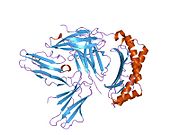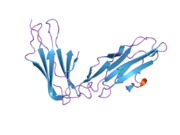LILRB2: Difference between revisions
Citation bot (talk | contribs) Add: doi-access. | Use this bot. Report bugs. | Suggested by Headbomb | Linked from Wikipedia:WikiProject_Academic_Journals/Journals_cited_by_Wikipedia/Sandbox | #UCB_webform_linked 82/1250 |
No edit summary |
||
| Line 4: | Line 4: | ||
This gene is a member of the [[leukocyte immunoglobulin-like receptor]] (LIR) family, which is found in a gene cluster at chromosomal region 19q13.4. The encoded protein belongs to the subfamily B class of LIR receptors which contain two or four extracellular immunoglobulin domains, a transmembrane domain, and two to four cytoplasmic immunoreceptor tyrosine-based inhibitory motifs (ITIMs). The receptor is expressed on immune cells where it binds to MHC class I molecules on antigen-presenting cells and transduces a negative signal that inhibits stimulation of an immune response. It is thought to control inflammatory responses and cytotoxicity to help focus the immune response and limit autoreactivity. Multiple transcript variants encoding different isoforms have been found for this gene.<ref name="entrez"/> |
This gene is a member of the [[leukocyte immunoglobulin-like receptor]] (LIR) family, which is found in a gene cluster at chromosomal region 19q13.4. The encoded protein belongs to the subfamily B class of LIR receptors which contain two or four extracellular immunoglobulin domains, a transmembrane domain, and two to four cytoplasmic immunoreceptor tyrosine-based inhibitory motifs (ITIMs). The receptor is expressed on immune cells where it binds to MHC class I molecules on antigen-presenting cells and transduces a negative signal that inhibits stimulation of an immune response. It is thought to control inflammatory responses and cytotoxicity to help focus the immune response and limit autoreactivity. Multiple transcript variants encoding different isoforms have been found for this gene.<ref name="entrez"/> |
||
LILBR2 plays a critical role in the inhibition of axonal regeneration and functional recovery after [[Brain damage|brain injury]].<ref>{{Cite journal|last=Mi|first=Ya-Jing|last2=Chen|first2=Hai|last3=Guo|first3=Na|last4=Sun|first4=Meng-Yi|last5=Zhao|first5=Zhao-Hua|last6=Gao|first6=Xing-Chun|last7=Wang|first7=Xiao-Long|last8=Zhang|first8=Rui-San|last9=Zhou|first9=Jiang-Bing|last10=Gou|first10=Xing-Chun|date=2017|title=Inhibition of PirB Activity by TAT-PEP Improves Mouse Motor Ability and Cognitive Behavior|url=https://pubmed.ncbi.nlm.nih.gov/28676756/|journal=Frontiers in Aging Neuroscience|volume=9|pages=199|doi=10.3389/fnagi.2017.00199|issn=1663-4365|pmc=5476690|pmid=28676756}}</ref> However, recent studies demonstrate that LILRB2 is a [[Amyloid beta|β-Amyloid]] receptor and may contribute to synaptic loss and [[Cognitive deficit|cognitive impairment]] in [[Alzheimer's disease]]. <ref>{{Cite journal|last=Lao|first=Kejing|last2=Zhang|first2=Ruisan|last3=Dai|first3=Yuxuan|last4=Luan|first4=Jing|last5=Guo|first5=Na|last6=Xu|first6=Xi|last7=Zhang|first7=Yuelin|last8=Gou|first8=Xingchun|date=2021-07-01|title=Identification of novel Aβ-LilrB2 inhibitors as potential therapeutic agents for Alzheimer's disease|url=https://www.sciencedirect.com/science/article/pii/S1044743121000439|journal=Molecular and Cellular Neuroscience|language=en|volume=114|pages=103630|doi=10.1016/j.mcn.2021.103630|issn=1044-7431}}</ref><ref>{{Cite journal|last=Kim|first=Taeho|last2=Vidal|first2=George S.|last3=Djurisic|first3=Maja|last4=William|first4=Christopher M.|last5=Birnbaum|first5=Michael E.|last6=Garcia|first6=K. Christopher|last7=Hyman|first7=Bradley T.|last8=Shatz|first8=Carla J.|date=2013-09-20|title=Human LilrB2 Is a β-Amyloid Receptor and Its Murine Homolog PirB Regulates Synaptic Plasticity in an Alzheimer’s Model|url=https://www.ncbi.nlm.nih.gov/pmc/articles/PMC3853120/|journal=Science (New York, N.Y.)|volume=341|issue=6152|pages=10.1126/science.1242077|doi=10.1126/science.1242077|issn=0036-8075|pmc=3853120|pmid=24052308}}</ref> |
|||
==Interactions== |
==Interactions== |
||
Revision as of 10:55, 11 December 2021
| LILRB2 | |||||||||||||||||||||||||||||||||||||||||||||||||||
|---|---|---|---|---|---|---|---|---|---|---|---|---|---|---|---|---|---|---|---|---|---|---|---|---|---|---|---|---|---|---|---|---|---|---|---|---|---|---|---|---|---|---|---|---|---|---|---|---|---|---|---|
| Identifiers | |||||||||||||||||||||||||||||||||||||||||||||||||||
| Aliases | LILRB2, ILT4, MIR10, LIR2, MIR-10, LIR-2, leukocyte immunoglobulin like receptor B2, ILT-4, CD85D | ||||||||||||||||||||||||||||||||||||||||||||||||||
| External IDs | OMIM: 604815; HomoloGene: 136797; GeneCards: LILRB2; OMA:LILRB2 - orthologs | ||||||||||||||||||||||||||||||||||||||||||||||||||
| |||||||||||||||||||||||||||||||||||||||||||||||||||
| |||||||||||||||||||||||||||||||||||||||||||||||||||
| |||||||||||||||||||||||||||||||||||||||||||||||||||
| Wikidata | |||||||||||||||||||||||||||||||||||||||||||||||||||
| |||||||||||||||||||||||||||||||||||||||||||||||||||
Leukocyte immunoglobulin-like receptor subfamily B member 2 is a protein that in humans is encoded by the LILRB2 gene.[3][4][5]
This gene is a member of the leukocyte immunoglobulin-like receptor (LIR) family, which is found in a gene cluster at chromosomal region 19q13.4. The encoded protein belongs to the subfamily B class of LIR receptors which contain two or four extracellular immunoglobulin domains, a transmembrane domain, and two to four cytoplasmic immunoreceptor tyrosine-based inhibitory motifs (ITIMs). The receptor is expressed on immune cells where it binds to MHC class I molecules on antigen-presenting cells and transduces a negative signal that inhibits stimulation of an immune response. It is thought to control inflammatory responses and cytotoxicity to help focus the immune response and limit autoreactivity. Multiple transcript variants encoding different isoforms have been found for this gene.[5]
LILBR2 plays a critical role in the inhibition of axonal regeneration and functional recovery after brain injury.[6] However, recent studies demonstrate that LILRB2 is a β-Amyloid receptor and may contribute to synaptic loss and cognitive impairment in Alzheimer's disease. [7][8]
Interactions
LILRB2 has been shown to interact with PTPN6.[9][10]
See also
References
- ^ a b c ENSG00000275463, ENSG00000131042, ENSG00000276146, ENSG00000277751 GRCh38: Ensembl release 89: ENSG00000274513, ENSG00000275463, ENSG00000131042, ENSG00000276146, ENSG00000277751 – Ensembl, May 2017
- ^ "Human PubMed Reference:". National Center for Biotechnology Information, U.S. National Library of Medicine.
- ^ Cella M, Dohring C, Samaridis J, Dessing M, Brockhaus M, Lanzavecchia A, Colonna M (June 1997). "A novel inhibitory receptor (ILT3) expressed on monocytes, macrophages, and dendritic cells involved in antigen processing". J Exp Med. 185 (10): 1743–51. doi:10.1084/jem.185.10.1743. PMC 2196312. PMID 9151699.
- ^ Samaridis J, Colonna M (April 1997). "Cloning of novel immunoglobulin superfamily receptors expressed on human myeloid and lymphoid cells: structural evidence for new stimulatory and inhibitory pathways". Eur J Immunol. 27 (3): 660–5. doi:10.1002/eji.1830270313. PMID 9079806. S2CID 2212182.
- ^ a b "Entrez Gene: LILRB2 leukocyte immunoglobulin-like receptor, subfamily B (with TM and ITIM domains), member 2".
- ^ Mi, Ya-Jing; Chen, Hai; Guo, Na; Sun, Meng-Yi; Zhao, Zhao-Hua; Gao, Xing-Chun; Wang, Xiao-Long; Zhang, Rui-San; Zhou, Jiang-Bing; Gou, Xing-Chun (2017). "Inhibition of PirB Activity by TAT-PEP Improves Mouse Motor Ability and Cognitive Behavior". Frontiers in Aging Neuroscience. 9: 199. doi:10.3389/fnagi.2017.00199. ISSN 1663-4365. PMC 5476690. PMID 28676756.
{{cite journal}}: CS1 maint: unflagged free DOI (link) - ^ Lao, Kejing; Zhang, Ruisan; Dai, Yuxuan; Luan, Jing; Guo, Na; Xu, Xi; Zhang, Yuelin; Gou, Xingchun (1 July 2021). "Identification of novel Aβ-LilrB2 inhibitors as potential therapeutic agents for Alzheimer's disease". Molecular and Cellular Neuroscience. 114: 103630. doi:10.1016/j.mcn.2021.103630. ISSN 1044-7431.
- ^ Kim, Taeho; Vidal, George S.; Djurisic, Maja; William, Christopher M.; Birnbaum, Michael E.; Garcia, K. Christopher; Hyman, Bradley T.; Shatz, Carla J. (20 September 2013). "Human LilrB2 Is a β-Amyloid Receptor and Its Murine Homolog PirB Regulates Synaptic Plasticity in an Alzheimer's Model". Science (New York, N.Y.). 341 (6152): 10.1126/science.1242077. doi:10.1126/science.1242077. ISSN 0036-8075. PMC 3853120. PMID 24052308.
- ^ Fanger, N A; Cosman D; Peterson L; Braddy S C; Maliszewski C R; Borges L (November 1998). "The MHC class I binding proteins LIR-1 and LIR-2 inhibit Fc receptor-mediated signaling in monocytes". Eur. J. Immunol. 28 (11): 3423–34. doi:10.1002/(SICI)1521-4141(199811)28:11<3423::AID-IMMU3423>3.0.CO;2-2. ISSN 0014-2980. PMID 9842885.
- ^ Colonna, M; Samaridis J; Cella M; Angman L; Allen R L; O'Callaghan C A; Dunbar R; Ogg G S; Cerundolo V; Rolink A (April 1998). "Human myelomonocytic cells express an inhibitory receptor for classical and nonclassical MHC class I molecules". J. Immunol. 160 (7): 3096–100. ISSN 0022-1767. PMID 9531263.
Further reading
- Suciu-Foca N, Cortesini R (2007). "Central role of ILT3 in the T suppressor cell cascade". Cell. Immunol. 248 (1): 59–67. doi:10.1016/j.cellimm.2007.01.013. PMID 17923119.
- Maruyama K, Sugano S (1994). "Oligo-capping: a simple method to replace the cap structure of eukaryotic mRNAs with oligoribonucleotides". Gene. 138 (1–2): 171–4. doi:10.1016/0378-1119(94)90802-8. PMID 8125298.
- Wagtmann N, Rojo S, Eichler E, et al. (1997). "A new human gene complex encoding the killer cell inhibitory receptors and related monocyte/macrophage receptors". Curr. Biol. 7 (8): 615–8. doi:10.1016/S0960-9822(06)00263-6. PMID 9259559. S2CID 14484039.
- Suzuki Y, Yoshitomo-Nakagawa K, Maruyama K, et al. (1997). "Construction and characterization of a full length-enriched and a 5'-end-enriched cDNA library". Gene. 200 (1–2): 149–56. doi:10.1016/S0378-1119(97)00411-3. PMID 9373149.
- Colonna M, Navarro F, Bellón T, et al. (1997). "A common inhibitory receptor for major histocompatibility complex class I molecules on human lymphoid and myelomonocytic cells". J. Exp. Med. 186 (11): 1809–18. doi:10.1084/jem.186.11.1809. PMC 2199153. PMID 9382880.
- Colonna M, Samaridis J, Cella M, et al. (1998). "Human myelomonocytic cells express an inhibitory receptor for classical and nonclassical MHC class I molecules". J. Immunol. 160 (7): 3096–100. PMID 9531263.
- Borges L, Hsu ML, Fanger N, et al. (1998). "A family of human lymphoid and myeloid Ig-like receptors, some of which bind to MHC class I molecules". J. Immunol. 159 (11): 5192–6. PMID 9548455.
- Fanger NA, Cosman D, Peterson L, et al. (1998). "The MHC class I binding proteins LIR-1 and LIR-2 inhibit Fc receptor-mediated signaling in monocytes". Eur. J. Immunol. 28 (11): 3423–34. doi:10.1002/(SICI)1521-4141(199811)28:11<3423::AID-IMMU3423>3.0.CO;2-2. PMID 9842885.
- Allan DS, Colonna M, Lanier LL, et al. (1999). "Tetrameric complexes of human histocompatibility leukocyte antigen (HLA)-G bind to peripheral blood myelomonocytic cells". J. Exp. Med. 189 (7): 1149–56. doi:10.1084/jem.189.7.1149. PMC 2193000. PMID 10190906.
- Lepin EJ, Bastin JM, Allan DS, et al. (2001). "Functional characterization of HLA-F and binding of HLA-F tetramers to ILT2 and ILT4 receptors". Eur. J. Immunol. 30 (12): 3552–61. doi:10.1002/1521-4141(200012)30:12<3552::AID-IMMU3552>3.0.CO;2-L. PMID 11169396.
- Young NT, Canavez F, Uhrberg M, et al. (2001). "Conserved organization of the ILT/LIR gene family within the polymorphic human leukocyte receptor complex". Immunogenetics. 53 (4): 270–8. doi:10.1007/s002510100332. PMID 11491530. S2CID 2819935.
- Chang CC, Ciubotariu R, Manavalan JS, et al. (2002). "Tolerization of dendritic cells by T(S) cells: the crucial role of inhibitory receptors ILT3 and ILT4". Nat. Immunol. 3 (3): 237–43. doi:10.1038/ni760. PMID 11875462. S2CID 35400503.
- Willcox BE, Thomas LM, Chapman TL, et al. (2003). "Crystal structure of LIR-2 (ILT4) at 1.8 A: differences from LIR-1 (ILT2) in regions implicated in the binding of the Human Cytomegalovirus class I MHC homolog UL18". BMC Struct. Biol. 2: 6. doi:10.1186/1472-6807-2-6. PMC 130215. PMID 12390682.
{{cite journal}}: CS1 maint: unflagged free DOI (link) - Strausberg RL, Feingold EA, Grouse LH, et al. (2003). "Generation and initial analysis of more than 15,000 full-length human and mouse cDNA sequences". Proc. Natl. Acad. Sci. U.S.A. 99 (26): 16899–903. Bibcode:2002PNAS...9916899M. doi:10.1073/pnas.242603899. PMC 139241. PMID 12477932.
- Shiroishi M, Tsumoto K, Amano K, et al. (2003). "Human inhibitory receptors Ig-like transcript 2 (ILT2) and ILT4 compete with CD8 for MHC class I binding and bind preferentially to HLA-G". Proc. Natl. Acad. Sci. U.S.A. 100 (15): 8856–61. Bibcode:2003PNAS..100.8856S. doi:10.1073/pnas.1431057100. PMC 166403. PMID 12853576.
- Nakajima H, Asai A, Okada A, et al. (2004). "Transcriptional regulation of ILT family receptors". J. Immunol. 171 (12): 6611–20. doi:10.4049/jimmunol.171.12.6611. PMID 14662864.
- Papanikolaou NA, Vasilescu ER, Suciu-Foca N (2005). "Novel single nucleotide polymorphisms in the human immune inhibitory immunoglobulin-like T cell receptor type 4". Hum. Immunol. 65 (7): 700–5. doi:10.1016/j.humimm.2004.04.003. PMID 15301858.
- Gerhard DS, Wagner L, Feingold EA, et al. (2004). "The status, quality, and expansion of the NIH full-length cDNA project: the Mammalian Gene Collection (MGC)". Genome Res. 14 (10B): 2121–7. doi:10.1101/gr.2596504. PMC 528928. PMID 15489334.
External links
- LILRB2+protein,+human at the U.S. National Library of Medicine Medical Subject Headings (MeSH)
- LILRB2 human gene location in the UCSC Genome Browser.
- LILRB2 human gene details in the UCSC Genome Browser.
This article incorporates text from the United States National Library of Medicine, which is in the public domain.




